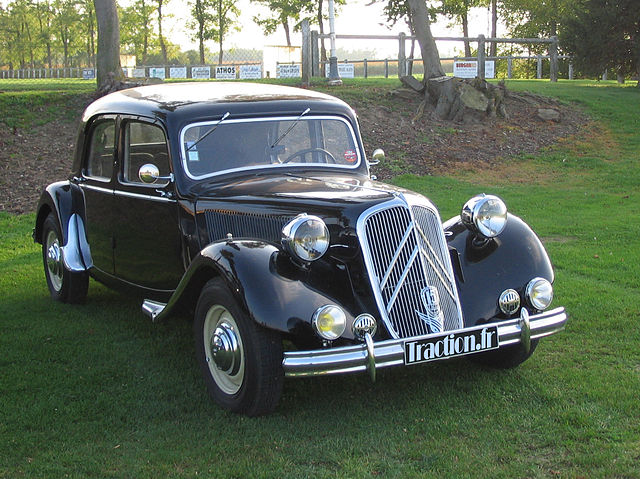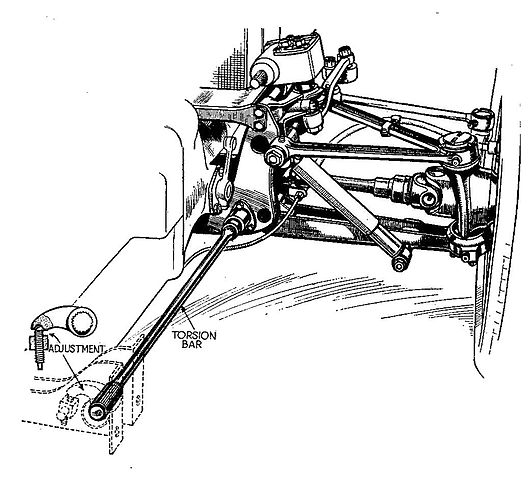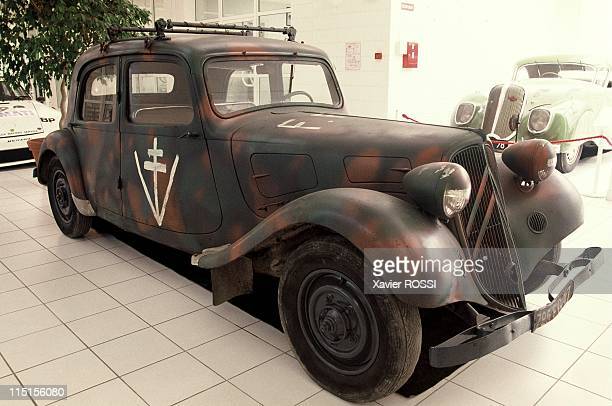Citröen Traction avant (1934)
 Staff Car, about 760,000 built 1934-57.
Staff Car, about 760,000 built 1934-57.
Although the Citroën "Traction Avant" is certainly not a military truck, it was however one of the most common and recoignisable French vehicle in 1940. It was used by the French Army, German Army and SS, Vichy state Milice, Gestapo, FFI under the occupation and the allies at the end of the war. It was the go-to vehicle here and then, innovative, modern, stable and fast. Not armed (by default) it was used as a liaison, staff car, VIP transport, and just became ubiquitous in France in WW2.
The Automotive innovator: André Citröen

If Citroën is a name almost forgotten today, part of PSA since 1976 and now superseded by the brand "DS", this company was once the most powerful and influencial automotive producer in France and Europe, in mass production, through constant innovation, and thanks to its modern communication, importing from the US tailorisation, and working with the best minds in advertising at the time. Its "yellow cruise" through Asia propularized the half-track concept and the brand at the same time, generating interest of many armies. The WW2 half-tracks M3 for example is a direct result of his belief in the Kegresse tracks.
Founded in 1919 with a logo that was inspired by cog's teeth, the company wanted to create the French Ford T, and popularized models such as the 1919 Citroën A 8CV, the 1921 Citroën B Torpedo and 1923 Type C 5CV. Gradually and even almost unaffected by the great depression, it's range included all types, bodies and engines capacities from simple worker's cars to luxury sedans and sporty coupes, and everything in between, but also trucks, buses, and military vehicles. It short, Citröen was a giant, heads and shoulders above Peugeot or Renault.
There are three vehicles fondly attributed to the brand today, four landmarks that eclipsed all others: The 1936 "Traction Avant" ("forward drive") subject of this post and during the war and occupation three others studied, unveiled in 1945 for the 2CV and HY van, 1955 for the DS. The first two were simple and cheap vehicles ideal to have everyone on the road again and all services to restart, whike the second cumulated more innovations that any other model of the fifties in a body that still turns head today.
The Traction Avant
The Citroën Traction Avant was the result of design work born from seeing the growing front-wheel drive market in Europe, on a flurry of models such as the German DKW and Adler, British BSA Scout and Alvis (1928 Racing FWD) and Cord L29 in the US. It presented many advantages while beign still an extremely rare configuration still, as the rear drive ruled since the start of the automotive. So for its next "familiale" or common sedan, André Citroen pressed the combination of front wheel drive, combined with another innovation driven by its taste for productive innovation: A welded unitary body/chassis. This monocoque design was inspired by aviation, and this was not at random:
André René Lefèbvre, it's architect, was from the aeronautical world. He studyied at Supaéro (aviation engienering school) and started work during WWI for Gabriel Voisin in March 1916, an aircraft manufacturer turned coachbuilder after the war, delivering some of the fastest and most striking muxury sportcars of the 1920s and until 1931.
Lefèbvre then worked for Renault until 1933 and joined Citroën, hired for the Traction Avant project. There, he was associated with the famioyus Italian stylist Flaminio Bertoni and Paul Magès. Their collaboratrion was behind the most iconic vehicles of the brand. But first and foremost the 1934 world's first monocoque-bodied, front-wheel drive mass-production car. This was an association never attempted before, and it resulted not only in 70 kgs. spared compared to a classic chassis-body structure, created a very resilient, sturdy vehicle that could be pushed over a cliff and start again, took the best of its front inline engine, and being lower on the road for extra agility and stability, something shared with "subaissé" ("extra-low") sportscars of the day.
Thus comb made the Traction Avant and instant hit when presented at the Paris motorshow of 1934, despite reticences of many in the industry about such approach. In 1936, the vehicle met the success it deserved, and Citröen introduced a range of mostly 4-door saloons and executive cars. The long wheelbase variant was called "Commerciale", and there was three row seating "Familiale" model. They were proposed on option with four and six-cylinder engines as the production went on until... 1957. Just as the mythical DS took off. So this mode, with some 760,000 units built, the Traction Avant became the world's first front-wheel drive monocoque car made in such quantity.
Given the fame of Citröen outside France it was also widely exported, and started to be produced under licence as well. In Portugal, it became popularly known as "arrastadeira", the "dragging machine".
Design

The Citroën Traction Avant is a historically significant automobile, produced by the French manufacturer Citroën from 1934 to 1957. It is renowned for its groundbreaking design and engineering features, which were revolutionary at the time of its introduction. Front-Wheel Drive: The Traction Avant was one of the first mass-produced cars to feature front-wheel drive, which improved handling and road grip.
The term "Traction Avant" literally means "front-wheel drive" in French. Unibody Construction: Unlike most cars of its era, which were built on a separate chassis, the Traction Avant utilized a unitary body construction. This method improved the car's rigidity and safety. Independent Suspension: The car featured independent suspension on all four wheels, providing a smoother and more stable ride compared to many of its contemporaries.
The car was designed by André Lefèbvre and Flaminio Bertoni, a talented duo who brought together innovative engineering and stylish aesthetics. Production Challenges: The development and production of the Traction Avant faced numerous challenges, including financial difficulties for Citroën. Despite these obstacles, the car successfully went into production and became iconic. Variants: The Traction Avant was available in several models, including different body styles like the sedan (berline), coupé, and convertible (cabriolet).

Engine Options: Over its production life, the Traction Avant was equipped with various inline-four and inline-six engines, with the latter providing more power and performance. It was coupled with a cast aluminium alloy transaxle, quite radical at the time. The car's advanced design influenced future automotive engineering and design. It is often regarded as a predecessor to modern front-wheel-drive cars. It also had influence of motorsports.
Whilst front-wheel drive and four-wheel independent suspension had been pioneered already by Auto Union and others a few years prior the Traction Avant really innovated by having these combined with a unibody/monocoque construction, crash resistant, with rack and pinion steering for a mass production. I had a very favourable weight distribution, aiding its advanced handling characteristics and the low profile helped cx (air penetration coefficient) and improved further top speed, 100 kph and well above being the norm with the 6-cylinder. There was the gear change was set in the dashboard, and the gear-shift mechanism was locked when the mechanical clutch was engaged and released, and with pendant pedals, umbrella-type handbrake control and front bench seats, made its interior roomy despite compact dimensions.

Traction Avant monocoque

Front torsion bar suspension
Thanks to these choice the vehicle gained a lower profile and stance by the absence of a separate chassis/frame so sharply distinguishing the Traction Avant visually from its taller contemporaries. It also participated, as said before in its racecar like stability, and despite having no powerful engines apart the V6, the vehicle could be driven in all confidence at break-neck speeds, negociating tight turns at a pace that would make a race pilot blush. This was found very handy as a police and chase car. Paris top brigades used it against organized crime in France just prior to the war, but also gangsters, which appreciated it for the same reasons, and during the occupation, both the Gestapo on one side, and resistance on the other. As a last note, these vehicles were painted black as the only available color until 1953 and until 1957, other colors were proposed, often only the body, while the wheels arches remained black, and accessories such as headlights, bumpers, tailgate and lights were optionally chrome-plated.
Production

On the 760,000 manufactured (many from 1948 to 1957) the model was declined into four main bodies. SWB and LWB as usual are the "long" and "short" wheelbases.
- 4-door saloon: As the name suggest, the rear ones were "suicide doors" hinged back. LWB and SWB.
- 2-door saloon: Sort of coupé with longer doors, rear seats, SWB.
- 2-door convertible, with a tarpaulin, SWB and V6 engine were a popular combination
- 5-door hatchback: With a modified rear cab and extra seat, deported spare wheel. Often LWB.
Short Wheelbase: 2,910 mm (114.6 in) 7 & 11 légère (light)
Long Wheelbase: 3,090 mm (121.7 in) 11CV normale & 15/6
Extra Long Wheelbase: 3,270 mm (128.7 in)11CV longue & 15/6 limousine
Engine choices (The transmission was always a manual 3-speed column/dash shift):
- 1.3 L 4-cyl. V
- 1.5 L 4-cyl. V
- 1.6 L 4-cyl. V
- 1.9 L I4 (4 cylinder, inline)
- 2.9 L I6 (6 cylinder, inline)
The Traction Avant "in service"

The Traction Avant was produced before, during, and after World War II. Despite the challenges of the war, it remained in production, showcasing its robust design and continued popularity. The car gained a reputation for reliability and performance, often being used by the police and resistance fighters during the war. Its sleek design also made it a popular choice among affluent buyers and enthusiasts. It still is an icon today on par with the gamorous DS, and have many international connoisseurs buying it still today on the collection market, such as Historian Tom Holland.
In 1936, the French army was proposed to test the vehicle for its staff cars needs. Initially the French Army lacked enthusiasm for the Traction Avant, deue to its supposed lack of ground clearance but by September 1939, roughly 250 were used by the French Army, mostly used on roads. With losses of cars at the frontier mounting, Citroën supplied a further 570 to the Army. They arrived between February and May 1940, many still on railways cars when France was defeated.
As France was mostly occupied, apart the southern rump stat of Vichy, many of the cars were re-registered with "WH..." (Wehrmacht Heer/Army command) license plates. Perhaps 700+ were requisitioned by the German Army in 1940 alone and it was just the start. Indeed, the authorities could requisite all the cars found, started with those unsold, parked at Citröen plants, and then those privately owned. This means perhaps two thousands ended as staff cars in German hanjds during the occupation, giving reliable service not only in France, but as the war progress, throughout Europe, in Libya and Stalingrad as well.

In France this became the "default" car of the German secret state police of Gestapo (Geheime Staatspolizei). It was fast and apreciated thus for quick police operations against discovered resistance nests. These vehicles were always black by default and without any recoignisable mark, just as the men themselves were in common civilian clothes. They were however easier to spot compared to standard privately owned vehicles as all gasoline was requisitioned as well, so the remainder used gazogene instead (a crudely refine coal mixture) and sported these tanks, or containers above the roof.
Not only the Gestapo or Wehmacht appreciated these, the SS also adopted these when in France. All HQ had some, usually camouflaged, some sporting a balkankreuz and standard German vehicle markings. In German service it was called the Citroen 7CV Traction Avant (7A, 7B, 7C, 7S). Production stopped at Citroene in 1941 but in German service about 1,800 were registered, they were often distinguished by the absence of cover on their rims.
As the war progressed and expecially in 1944, traction Avants were also favoured by the Resistance. They were found ideal for quick "coup de poing" (fist hit) operations against German personal and assets. Some were used for example for the escape of resistance fighters in transit in Lyon (search Lucie Aubrac for more). At the liberation in the summer of 1944 and up to Paris insurrection in August, they turned up all over France with "FFI" inscribed proudly on their doors (Forces Francaises of the Interior). Less gloriously, the cars were known as favourites among gangsters such as Pierrot le Fou and his Traction gang as said above about the police.
They became the default Free French vehicles during the reduction of the last German pockets in France in 1945 as well. Many were also used by US Forces stationed in France as well. The military Police (MP) were known to prefer them over the unstable and less comfy jeeps, albeit this went against regulations. Postwar, as production resumed, the vehicle benefited (at least on France) from at least the souvenir of FFI over the Gestapo. The Citroën Traction Avant remains a celebrated model in automotive history, remembered for its pioneering technology and elegant design. It set a high standard for future developments in car engineering and design, securing its place as a classic icon in the automotive world.
| Specs Citröen Traction Avant, 1.9 L I4 SWB |
| Dimensions : | 4,450 x 1,620 x 1,520(175.2 x 63.8 x 59.8) |
| Total weight: | 900kg light, 1,025 (2,260 lb) |
| Crew: | 5 passengers |
| Propulsion: | See notes |
| Speed: | Best 72.6 mph (116.8 km/h) |
| Range: | c600 km |
| Production | 760k by 1957 |
Links/Src
traction.ch
Citroën Traction Avant "Citroen sous l'uniforme", Bertrand de Lamotte, François Vauvillier.
In German Service
driving.co.uk
flatout.com.br
citroenet.org.uk
camac.forumactif.fr
dissidence44d2m.forum-actif.net
conceptcarz.com
leadadventureforum.com
toofatlardies.co.uk
autoevolution.com






